If you are wondering which would be the best snake for pets, it’s common that you can think of only a handful of pet snakes. There are more than 20 species of snakes that can be great pets, with a range of character traits and features.
You might find yourself opting for one type over another based on factors like size and temperament. Some people also choose to have multiple pet snakes at once, which can give each snake the attention they need.
Here is a list of the good snakes to have as pets for you! Once read, you can easily choose your pet snake.
How to choose the perfect pet snake
- Before choosing a snake as a pet, think carefully about how long your pet can last! The reason is that many of these species have an average lifespan of 15 to 20 years.
- It is also important for you to be aware and prepared about the food of this pet. That list includes pre-killed frozen prey such as rats. For this, you have to make arrangements to keep the iceberg.
- They are fugitives, so you have to make a good arrangement.
Best snakes to have as pets
Snakes are one of the best pets to have, but which type of snake is the best option? The answer may surprise you.
The three common types of snakes that live indoors are corn snakes, ball pythons, and garter snakes.
These types of snakes make an excellent pet for any beginner as they are easy to handle and easily available in captive species.
However, in addition to these three species, there are several other species that you can keep as pets. Please read this article carefully so that you can determine the best pet.
1. Corn Snake
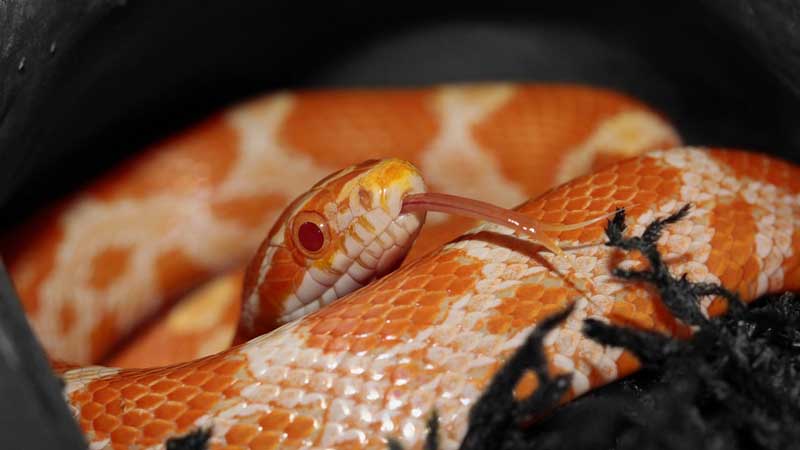
The Corn Snake is a great choice for beginners. They’re easy to care for and the perfect size for small terrariums.
The pattern of the Corn Snake can vary from light beige to dark brown, but it’s always found with orange and yellow bands along its body.
They’re very docile creatures that don’t bite or scratch, making them the perfect first pet!
Corn snakes are escape artists! They can even slither through an opening as small as a quarter, which is why it’s important to keep them in a secure enclosure.
If they feel threatened, they may vibrate their tails in defense; this is not venomous but can be startling.
Unlike other reptiles, corn snakes are carnivores and require a diet of pre-killed frozen mice. Give your snake the best variety of food with our selection of live and pre-killed frozen mice! Regular feedings will help ensure your snake stays healthy and happy.
They are easy to take care of and make for an excellent beginner snake pet.
Corn snakes are also one of the most popular snakes as pets in the world. They aren’t aggressive and don’t require a lot of space or special care.
2. California Kingsnake
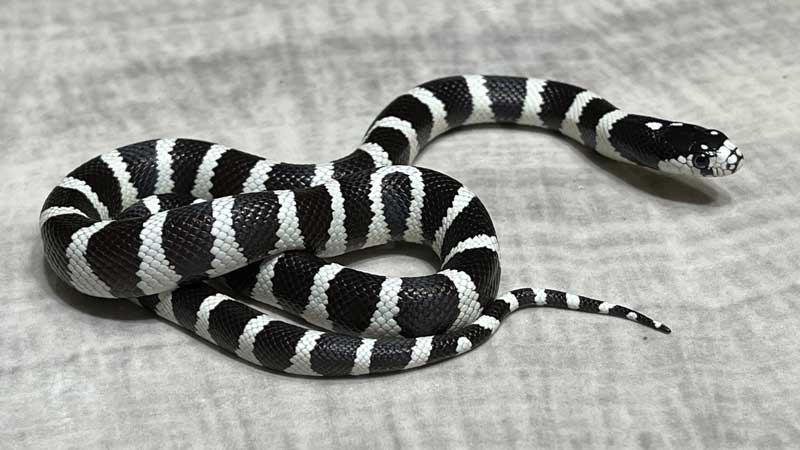
The California Kingsnake is a non-venomous snake of the kingsnake genus. They can be found in various habitats, and are immune to most venoms.
This unique snake is often called the “King” of snakes because it does not have any natural predators.
They’re not venomous so they make a great addition to any family.
California Kingsnakes are among the most beautiful of all snakes. Their color is alternating between white and black bands, with some morph variations that include whites, yellows, browns, and blacks in different patterns.
California kingsnakes are nocturnal snakes which means they are mostly active at night.
If they are disturbed, they will coil their bodies and hide their heads. If you see them during the day, it is because they have been disturbed in some way. They will also rattle their tails when threatened or scared.
The California Kingsnake is an amazing animal that can be kept in captivity as a pet.
This snake is a carnivore and eats prey including frogs, birds, rodents, and lizards. The food should be bought frozen and thawed to provide the best nutrition for your pet.
They are docile, yet peppy and thrive in several environments, which make them suited for both first-time snake owners and those with experience holders. And they’re even legal in most states! A perfect choice for anyone looking to make a new friend in their home.
3. Ball Python

Ball Pythons are ideal pets for people who are new to snake ownership. They’re one of the easiest snakes to keep in captivity, and they’re also among the most docile and least likely to bite.
If you have children, a Ball Python is another great choice since they’re gentle and easy to handle.
There are many benefits of adopting a Ball Python as your pet. In addition to being an appealing pet for beginners, these animals are also inexpensive, long-lived, and very easy to maintain.
On top of that, Ball Pythons can be quite interactive with their owners—many will allow you to hold them or pick them up without any hesitation. With so many benefits it’s not hard to see why they make such great pets.
The Ball Python is a shy species that prefers to spend its days hiding in underground burrows.
They are nocturnal hunters and will wait for their prey to come down to the surface before striking.
They spend their days resting and they hunt at night for rodents, small birds, frogs, lizards, and insects. They are finicky eaters who will only eat live prey.
Ball pythons are largely carnivorous, and they enjoy a diet of baby mice and rats. Frozen-thawed mice are also a good option, as long as you feed them fresh water daily.
Ball Pythons are among the most popular pet snakes in the world. These docile reptiles are perfect for beginners, as they don’t get too big and they’re often calm and shy.
Ball Pythons also make great pets because they’re easy to care for, meaning you can show up with minimal knowledge and be off to a great start.
4. Western Hognose Snake
The western hognose snake is native to North America. They enjoy inhabiting wooded areas with dense ground cover.
These snakes prefer to spend their time on damp ground and under logs or leaf litter.
Western hognoses typically live in burrows that they make themselves or borrow from other animals.
Hognose Snakes tend to play dead when threatened by predators or humans.
The snake will curl up in an almost perfect ball with its head tucked into its stomach as if it was just dead.
This behavior often saves them from becoming prey because animals tend to ignore snakes that look like they are already dead or gone.
These snakes feed on lizards, frogs, toads, birds eggs, small mammals. Even though they are considered carnivores they will also eat some vegetables if they have an opportunity.
Western hognose snakes can be fed store-bought food or live prey. These snakes can be offered frozen or thawed mice as well!
Hognose snakes are known for their acting skills when threatened or handled too aggressively. As a pet, this snake is becoming the main choice for many.
These snakes are great pets because of their majestic personality.
5. Rosy Boa
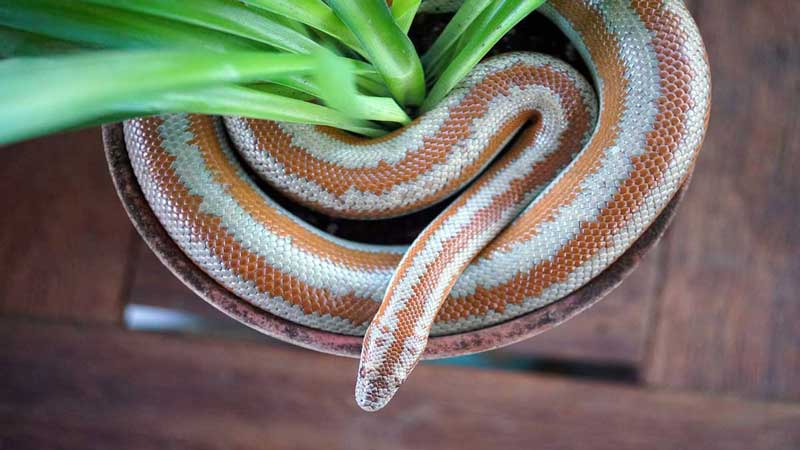
A Rosy Boa is a cool-tempered snake found in California. This snake is suitable for first-time keepers and is calm.
They have a light gray, yellow, or tan base with a deep maroon, orange, or brown stripe color.
Rosies have habitats that change based on their location. Those from California’s Mojave and Colorado deserts live mostly in burrows and rocky outcroppings.
These snakes prefer to keep their environment cool by staying underground or underneath large boulders for most of day time hours.
A pink boa is a carnivorous diet which means it likes to eat mainly meat, they usually eat lizards, small mammals, birds, eggs, other snakes, and sometimes small frogs or toads.
If your pink boa is rushing for food in captivity, you should provide it with hunting material most of the day. One of these options would be live baby rats or rats that have been burned but not skinned.
Often considered one of America’s most docile snake species, rosy boas are typically very calm and harmless.
They have short fangs that are too small to pierce human skin but can easily kill other prey animals. These snakes grow on average to three feet long and have light-colored bellies and dark-colored saddles on their backs.
The rosy boa is also one of the few nonvenomous snakes that have red eyes. The snake is good for first-time owners because it is not aggressive at all.
It has such a mellow temperament that you can pick it up by hand without getting bitten or scratched. So it will be great to start as a beginner!
6. Garter Snake
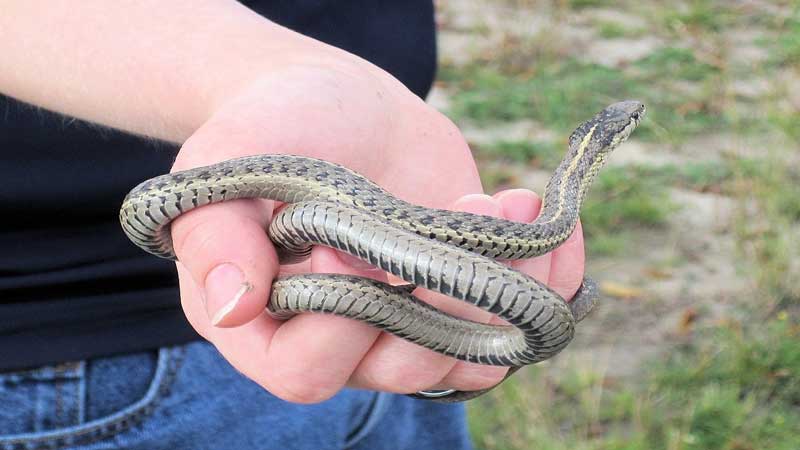
One of the most popular pet snakes is the garter snake. Garter snakes are not contractors and they are not poisonous either.
They range in size from two feet to about four feet long.
They are also daily, which means they are active during the day so they have good eyesight which they use to find and catch prey with an intense sense of smell.
Garter snakes are small Colbred snakes that live in North America and other parts of the world.
Garter snakes are relatively easy to care for. They have no particular dietary needs other than feeding them live or pre-killed food once every 7-10 days.
Be careful when picking up garter snakes because they may release some musk from their scent glands, which is used as an alarm signal in nature.
All in all, garters make great display pets because they are relatively low maintenance.
Garter snakes are insectivores that need to eat every day. They also will eat other small animals, amphibians, and rodents.
This includes live prey as well as dead prey found outside or in captivity. The easiest way is by feeding your garter snake live crickets, fish, and other small insects.
As seen in the above description, garter snakes make great pets because they are very alert and active.
7. Milk Snake
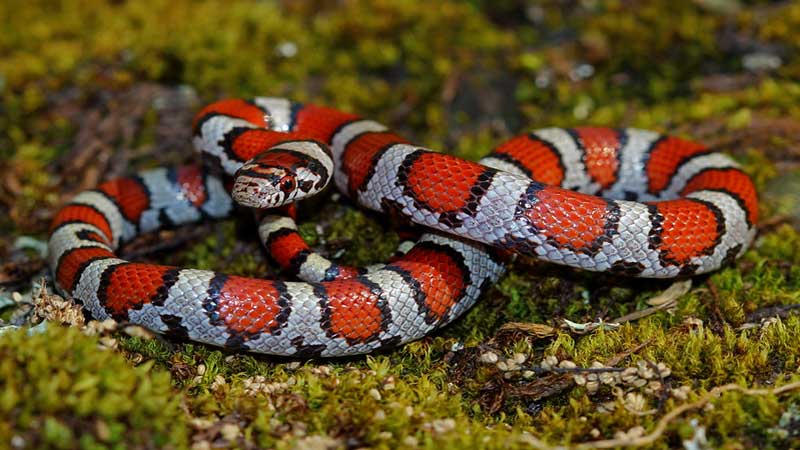
The milk snake is a non-venomous snake that feeds primarily on rodents and other small mammals.
As they are constrictors, they kill their prey by suffocating it. However, they lack the ability to envenom ate their prey with a toxic bite.
As such, milk snakes are among the most benign and docile of snakes, making them easier to handle than many other species.
8. Gopher Snake
The gopher snake is native to North America. It ranges from Western Canada to Mexico and can be found in areas of grassland, marshland, desert, and savannah.
Their diet consists mostly of rodents, but they will also eat lizards, birds, and eggs if needed.
The gopher snake has many warning mechanisms against potential predators that include hissing and puffing up its body with air to make it look larger than it is.
If these techniques don’t work then he may strike with venomous fangs.
The carpet python is one of New Guinea and Australia’s longest-living and most docile snakes.
This snake will grow to be around 3.5 meters in length with an average lifespan of 15-25 years.
9. Carpet Python
Despite their size, they are relatively easy to look after as they prefer frozen mice, rats, quails, and rabbits over fresh meat.
They should also be taken on weekly outings where possible to encourage regular exercise.
10. Children’s Python
A lot of people might think that buying a python is a high-maintenance pet. But in reality, they are one of the easiest pets to own.
Children’s Pythons are nocturnal and they can live 20+ years. They will grow up to approx. 3 to 5 feet.
They like to eat frozen mice, rodents, birds. Children’s Pythons are low-maintenance pets; they also need feeding every 5-6 days, sometimes more depending on their size.
11. Common Boa Constrictor
There are many different types of boa constrictors but the most common type is the common boa constrictor.
Boa Constrictors are native to parts of North, Central, and South America.
They are generally quite docile in temperament and can become quite tame and calm pets.
Read this to know more about Amazon Tree Boa
12. Rough Green Snake
The rough green snake is not venomous. They live in thickly vegetated areas throughout the Chesapeake Bay region and their length can grow to be 1.8-2.6 feet long.
The rough green snake typically has rough scales and its belly is white, cream or yellow.
13. Rat Snake
A rat snake is native to southern Indiana and Florida. They are found most commonly along with waterways.
A rat snake’s diet includes small animals, frogs, eggs, mice, lizards, and sometimes other rat snakes.
Their shedding cycle is once per year when they are ready to shed their skin for their next life stage.
They eat about one meal per week which would mean that they do not need to be fed often so they would make great pets for people who don’t have much time to spend caring for them.
14. African Egg-Eating Snake
Do you want a snake that eats only eggs? If so, then the African Egg-Eating Snake might be for you. This snake approx a 2.5-foot long snake that ranges throughout Africa. The one disadvantage of this snake is that it only eats eggs, which can make feeding difficult.
15. Dekay’s Brown Snake
The brown snakes on the deck are small, they can be 1 foot or more in length.
The body has dark brown or tan skin, has two rows of dark spots on the back, and often has light marks on the back.
The abdomen can range from gray to pink and has black spots.
This snake has venom that can cause tissue necrosis, sometimes resulting in life-threatening secondary infections. Fortunately, their venom is not very potent.
16. Cape House Snake
Cape house snakes are one of many types of good pet reptiles that you can choose to purchase for your household.
One thing to note about cape house snakes is that they will try to escape at any given chance they get, so be sure to keep them in an enclosure with no open holes or cracks for escape routes.
When handling your pet’s enclosure, please keep in mind that they will often bite when scared or provoked by prey movement or loud noises coming from outside their home.
With their relaxed temperament and low-maintenance care requirements, the Cape house snake is great for any person who is looking for a pet snake to share their home with.
17. Rainbow Boa
The Argentine rainbow boa can make an excellent pet snake because they display vibrant colors and produce an abundant amount of rainbows.
They inhabit lower Central America in South America, so they may require heat lamps during certain months of winter.
So, When owning any type of snake it is always advisable to have patience as well as discipline for them as they are wild animals and will not easily tame.
Keeping all aspects of health and safety in mind when handling any reptile, many find that rainbow boas are some of the less challenging snakes to have as pets.
18. Ringneck Snake
Snakes are often considered early because they usually do not require much care and food. They should be fed once every 2 weeks. lizards, small salamanders, frogs, earthworms are their primary food
They are fairly small on average compared to other pets such as hamsters and rabbits; Ringneck snakes can grow up to 15 inches long!
Since they don’t require too much space, ringneck snakes can make good beginner pets but you still need to know if you want them as pets before deciding.
You will need natural decorations such as terrariums such as artificial plants and rocks where your rings can provide the excitement that helps them feel more comfortable in their new home.
19. Smooth Green Snake
The smooth green snake is a terrestrial snake found in southern Canada and the United States.
It is a relatively small, non-venomous snake that grows to be only 10-12 inches long. It eats things like crickets, roaches, caterpillars, and other non-hairy insects that can be found on the ground.
As a pet, these snakes are easy to care for with proper feeding and housing.
Feed them at least three times a week and make sure they have enough water in their cage.
Conclusion
As someone who has had experience with many different kinds of snakes, Python reticulates are one of my favorite varieties!
While they are not always great for new pet owners (due to their large size), they are perfect if you know how to care for them properly.
As long as you have time to give these beautiful creatures ample attention and provide them with plenty of room to roam around in, they will be very happy!
In general, Corn Snakes are one of my favorite choices because they’re so easy to handle!
They can grow up to five feet long but usually only reach lengths in between two and three feet when they’re adults – perfect for any apartment or small house owner!

